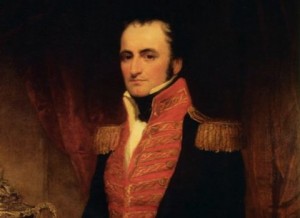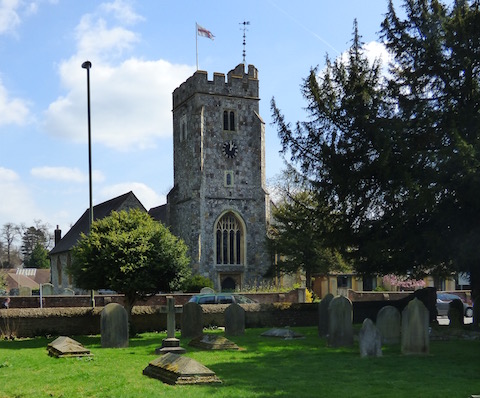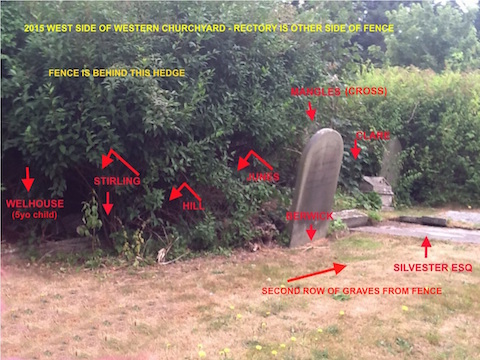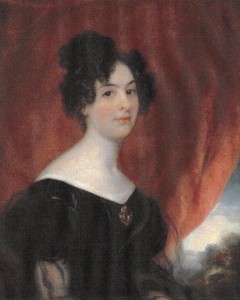 Abraham Lincoln
If given the truth, the people can be depended upon to meet any national crisis...
Abraham Lincoln
If given the truth, the people can be depended upon to meet any national crisis...
 Guildford news...
for Guildford people, brought to you by Guildford reporters - Guildford's own news service
Guildford news...
for Guildford people, brought to you by Guildford reporters - Guildford's own news service
Bid For Conservation Area Around Stoke Church And Claims Stirling’s Grave Has Been Located
Published on: 21 Jan, 2016
Updated on: 23 Jan, 2016
A group of residents who live in the area around St John’s Church in Stoke Road are hoping it can become a conservation area. And they are also claiming they have located the final resting place in the church’s west churchyard of Admiral Sir James Stirling, who was the founder and first governor of Western Australia.
It follows on from residents who objected to the church’s proposals last year to exhume the human remains in the west churchyard, re-bury them in the east churchyard and sell the land to raise funds for a new church centre.
Among further stories and comments, our story published in May 2015, reported that the Anglican Church’s Church Commissioners had turned down the church’s plan.
Local resident Donna Collinson was one of those who came out strongly against the church’s plans. She says that a far greater appreciation of the west churchyard and the immediate area’s special historical significance has now been realised.
Last year local historian and Guildford Dragon NEWS writer David Rose put Donna in contact with Western Australian resident Sid Breeden, who has long been trying to find the location of Stirling and his wife Ellen’s remains. (In Western Stirling is held in high regard, but few people in Guildford appear to take notice of his achievements Down Under). See previous story.

Admiral Sir James Stirling, the first governor of Western Australia, buried somewhere in St John’s Churchyard..
It has been a long saga that includes some mysteries back in 1970s when part of the west churchyard was used to build a new rectory (in Joseph’s Road, with work starting in the autumn of 1975), and it appears a number of graves were disturbed. The pink granite memorial to Stirling was smashed, but fortunately was saved and can now be seen sited between the church and the Stirling Centre. But the admiral’s remains are not there.
Donna said: “Being introduced to Sid Breeden last year set up a chain of events that has led with the help of Dr Steve Errington, vice-president of the Royal Western Australian Historical Association, and local professional genealogist Rosemary Morgan, to the discovery, through careful analysis, of the original St John’s church burial records of the final resting place of Admiral Sir James Stirling.
“This really has been a truly successful international effort. Plans for a new memorial to replace Admiral Sir James’ pink granite memorial smashed in 1977 are being revisited by the West Australian premier.
The researchers claim that his remains are indeed still in the west churchyard and not lost under the rectory building and garden (no longer in the church’s possession), or scattered elsewhere. However, the site they indicate is very close to the boundary fence!
However, local historian Carol Brown – who worships at the church, and who with others at the church, including the rector, the Rev Mark Woodward, has also been studying the burial books and researching the Stirling saga – is not convinced by the other party’s claims.
She said: “According to my findings some graves in the area have been moved, particularly when the rectory was built in 1977. It doesn’t add up as some of the graves are not in situ with the records. I would like to know more of their evidence as I am as concerned as they are to find his final resting place.”
Carol also added some details that appear to reveal that when Scots-born Stirling died in 1865 the status he had in Western Australia was not much appreciated here.
He and his wife Ellen, who was born at nearby Woodbridge House, returned to Guildford to live out their later years. Carol said: “In the burial book it states the church’s curate took the funeral. The fact that the rector did not take the service suggests he was not in high regard.”
Perhaps Victorian Guildfordians didn’t know much or care about the man who had been living among them for several years – a bit like it appears today. Guildford, Surrey, could, but does not appear to have many links with Guildford in Western Australia.
Also last year, English Heritage refused a bid to list Stirling’s grave, stating: “…the significance of Sir James Stirling’s contribution to British colonial history is not enough to make the grave worthy of inclusion on the National Heritage List for England.”
Of the bid for conservation area status, Donna Collinson cites the recent archaeological finds from as far back as the Palaeolithic, Mesolithic and Neolithics periods discovered by archaeolosists who dug the site before Guildford’s new fire station was built, the listing of the war memorial in Stoke Road, eight of the trees in the churchyard now being granted preservation orders, Historic England recognising the churchyard, and historic cottages in the area, all good reasons for the status to be recognised.
Donna said: “Architect Niels Laub and myself, prepared a draft conservation area character appraisal, which was submitted to our local Guildford borough councillor Caroline Reeves and to Mariana Beadsworth, the council’s principal design and conservation officer, towards justifying and substantiating our request for conservation area status, which has received praise and recognition.
“A public meeting was held back in August in St John’s Stirling Centre to present local residents with the social and architectural history of the area and to promote the move towards obtaining conservation area status. A vote taken at the meeting showed overwhelming public support and a draft has been circulated to all residents.”
Donna adds that she and her colleagues are now keeping on eye on and responding to the latest proposal for the former fire station site, which she says residents agree is a far better proposal than that of 2012.
The plans are for the demolition of the former fire station and replace it with a non-food retail warehouse.
Responses to Bid For Conservation Area Around Stoke Church And Claims Stirling’s Grave Has Been Located
Leave a Comment Cancel replyPlease see our comments policy. All comments are moderated and may take time to appear.

See Dragon story: GBC’s Explanation of Major Land Sale Notice Error ‘Borders on Arrogant’ Says Councillor







Recent Articles
- City and Manager ‘Part Company’ After Slide in Results
- PCC Election Result – Conservative Lisa Townsend Retains Commissioner Role
- Letter: It’s a Sad State of Affairs
- Times Rankings Showing GBC To Be Worst Council in Surrey Dismissed by Lib Dems
- Birdwatcher’s Diary No.303
- Letter: What a Scoop!
- Filmfest – a Festival of German Films
- Letter: Help Abroad Should Not Be to the Detriment of Those Here
- Armed Police Deployed After Fight at Ash Vale Pub – Four Arrested
- Surrey Schools Could Have ‘Meat-free Mondays’ If Strategy Adopted


Recent Comments
- Frank Emery on Latest Figures Show Two in Every Three Burglaries Went Unattended in Surrey
- Sara Tokunaga on Surrey Schools Could Have ‘Meat-free Mondays’ If Strategy Adopted
- John Lomas on Letter: Jeremy Hunt Has Not Engaged With Ash Parish Council As Claimed
- Jane Austin on Letter: Jeremy Hunt Has Not Engaged With Ash Parish Council As Claimed
- David Humphries on Letter: It’s a Sad State of Affairs
- David Roberts on Letter: Help Abroad Should Not Be to the Detriment of Those Here
Search in Site
Media Gallery
Dragon Interview: Local Artist Leaves Her Mark At One of England’s Most Historic Buildings
January 21, 2023 / No Comment / Read MoreDragon Interview: Lib Dem Planning Chair: ‘Current Policy Doesn’t Work for Local People’
January 19, 2023 / No Comment / Read MoreA3 Tunnel in Guildford ‘Necessary’ for New Homes, Says Guildford’s MP
January 10, 2023 / No Comment / Read More‘Madness’ for London Road Scheme to Go Ahead Against ‘Huge Opposition’, Says SCC Leader
January 6, 2023 / No Comment / Read MoreCouncillor’s Son Starts Campaign for More Consultation on North Street Plan
December 30, 2022 / No Comment / Read MoreCounty Council Climbs Down Over London Road Works – Further ‘Engagement’ Period Announced
December 14, 2022 / No Comment / Read MoreDragon Interview: GBC Reaction to the Government’s Expected Decision to Relax Housing Targets
December 7, 2022 / No Comment / Read MoreHow Can Our Town Centre Businesses Recover? Watch the Shop Front Debate
May 18, 2020 / No Comment / Read More









Sid Breeden
January 22, 2016 at 7:28 am
While I wholeheartedly support Donna Collinson and local residents bid for a conservation area, I’d like to restrict my comment to the Admiral Sir James and Ellen Stirling aspect.
Firstly, a correction. The rectory at 2 Joseph’s Road was not built in 1977. Clearing the far western part of the western churchyard commenced in 1974 (Order in Council is dated 18 December 1974 but workmen information indicates work started before then).
Rectory dwelling construction commenced in autumn 1975 and September 1976 saw the new curate move in with his family. It should be noted that at this time St John’s was part of Rev’d John Skinner’s St Saviour’s parish.
1977 was the year Western Australian TV producer John Izzard found the smashed Stirling gravestone under a pile of rubble about to go to a rubbish dump.
Stirling’s intact gravestone was physically observed and recorded in the mid-1970s. The evidence points to his area of headstones being illegally wrecked between September 1976 and March 1977 – likely in 1976 when the timber fence was installed between churchyard and rectory boundary.
It would be most helpful if Carol Brown could provide some detail to back her comments. I have reviewed the burial records analysis carried out by Dr Steve Errington and Rosemary Morgan. The burial records notations are precise and the moving of some headstones can be explained.
Stirling’s death in April 1865 was overshadowed by the assassination of USA President Abraham Lincoln. The president’s assassination took over world-wide headlines and was the main news subject in UK.
The fact that the curate conducted James Stirling’s burial was most probably because the rector at the time, Rev’d Francis Paynter, was away from Stoke. It should be noted that Rev Paynter conducted Lady Ellen Stirling’s burial in 1874 and she was buried with her husband.
Incidentally, Ellen saw out her days at her daughter Elinor’s home in Middlesex. Elinor was the last-born Stirling in Western Australia before they returned to England.
My understanding is English Heritage could not list the Stirling grave because firstly the location was unknown. Additionally EH has strict criteria for memorials to be considered for listing and even the reassembled relocated memorial design did not meet those criteria. It was not the man but the physical circumstances that denied listing.
Many Stirling direct descendants have recently expressed in writing their wish for the delayed Western Australian state memorial for Stirling be installed in the western churchyard. Let us hope the church and government re-enter successful negotiations.
Sid Breeden
Perth Western Australia
[Ed: Thank you Sid for your comment. Date of rectory construction now amended in the story.]